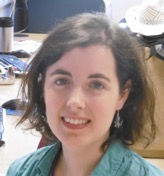Warwick Integrative Synthetic Biology Centre and School of Life Sciences, University of Warwick, Coventry , UK Translation initiation events on structured eukaryotic mRNAs generate gene expression noise Nucleic Acids Research, 2017, doi: 10.1093/nar/gkx430 Estelle Dacheux, Naglis Malys, Xiang Meng, Vinoy Ramachandran, Pedro Mendes & John EG McCarthy
Cv
Estelle Dacheux, 31 ans, a suivi une formation en Biologie Moléculaire et Cellulaire à l’Université de Montpellier II (Licence), puis à l’Université de Lyon I (Master recherche) avant d’effectuer une thèse au Centre de Recherche en Cancérologie de Lyon sous la direction du Dr. Nicole Dalla Venezia. Sa thèse, défendue en 2013, portait sur l’implication de la protéine onco-suppressive BRCA1 dans la régulation de la traduction et a permis l’identification de cibles traductionnelles de BRCA1 potentielles, dans la lignée de cellules épithéliales mammaires MCF7. Cette découverte l’a conduite à s’intéresser de près aux mécanismes de régulation post-transcriptionnelle chez les Eucaryotes. Elle a donc rejoint l’équipe du Pr. John McCarthy pour un post-doctorat en vue d’étudier la stochasticité générée au niveau traductionnel chez la levure Saccharomyces cerevisiae. Les résultats de cette étude, publiés dans Nucleic Acid Research, ont permis de montrer que la présence de structures secondaires stables dans la région 5’ non traduite des ARN messagers augmente le « bruit » généré au niveau traductionnel. Cet effet contribue significativement à la stochasticité globale de l’expression des gènes. A présent, Estelle a rejoint l’équipe de Micheline Fromont-Racine à l’Institut Pasteur à Paris pour s’intéresser aux mécanismes de dégradation des ARNm aberrants et des peptides correspondant chez Saccharomyces cerevisiae.
Contact
Dr Estelle Dacheux
Post-Doctoral Fellowship Researcher
Pr John McCarthy’s lab (M015, MRI building)
Warwick Integrative Synthetic Biology centre (WISB)
School of Life Sciences
University of Warwick
+44 (0)24 76 574242
http://www.wisb-uow.co.uk
Résumé de l'article
Gene expression stochasticity plays a major role in biology, creating non-genetic cellular individuality and influencing multiple processes, including differentiation and stress responses. We have addressed the lack of knowledge about posttranscriptional contributions to noise by determining cell-to-cell variations in the abundance of mRNA and reporter protein in yeast. Two types of structural element, a stem-loop and a poly(G) motif, not only inhibit translation initiation when inserted into an mRNA 5΄ untranslated region, but also generate noise. The noise-enhancing effect of the stem-loop structure also remains operational when combined with an upstream open reading frame. This has broad significance, since these elements are known to modulate the expression of a diversity of eukaryotic genes. Our findings suggest a mechanism for posttranscriptional noise generation that will contribute to understanding of the generally poor correlation between protein-level stochasticity and transcriptional bursting. We propose that posttranscriptional stochasticity can be linked to cycles of folding/unfolding of a stem-loop structure, or to interconversion between higher-order structural conformations of a G-rich motif, and have created a correspondingly configured computational model that generates fits to the experimental data. Stochastic events occurring during the ribosomal scanning process can therefore feature alongside transcriptional bursting as a source of noise.




